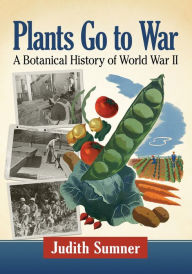-
Free ebook textbook downloads pdf Plants Go to War: A Botanical History of World War II iBook CHM FB2 9781476676128
Plants Go to War: A Botanical History of World War II by Judith Sumner


- Plants Go to War: A Botanical History of World War II
- Judith Sumner
- Page: 366
- Format: pdf, ePub, mobi, fb2
- ISBN: 9781476676128
- Publisher: McFarland & Company, Incorporated Publishers
Plants Go to War: A Botanical History of World War II
Free ebook textbook downloads pdf Plants Go to War: A Botanical History of World War II iBook CHM FB2 9781476676128
As the first botanical history of World War II, Plants Go to War examines military history from the perspective of plant science. From victory gardens to drugs, timber, rubber, and fibers, plants supplied materials with key roles in victory. Vegetables provided the wartime diet both in North America and Europe, where vitamin-rich carrots, cabbages, and potatoes nourished millions. Chicle and cacao provided the chewing gum and chocolate bars in military rations. In England and Germany, herbs replaced pharmaceutical drugs; feverbark was in demand to treat malaria, and penicillin culture used a growth medium made from corn. Rubber was needed for gas masks and barrage balloons, while cotton and hemp provided clothing, canvas, and rope. Timber was used to manufacture Mosquito bombers, and wood gasification and coal replaced petroleum in European vehicles. Lebensraum, the Nazi desire for agricultural land, drove Germans eastward; troops weaponized conifers with shell bursts that caused splintering. Ironically, the Nazis condemned non-native plants, but adopted useful Asian soybeans and Mediterranean herbs. Jungle warfare and camouflage required botanical knowledge, and survival manuals detailed edible plants on Pacific islands. Botanical gardens relocated valuable specimens to safe areas, and while remote locations provided opportunities for field botany, Trees surviving in Hiroshima and Nagasaki live as a symbol of rebirth after vast destruction.
Leontopodium nivale - Wikipedia
Leontopodium nivale, commonly called edelweiss is a mountain flower belonging to the daisy or sunflower family Asteraceae. The plant prefers rocky limestone places at about 1,800–3,000 metres Alpen Edelweiß, Leontopodium alpinum 2. . During World War I (1915), the edelweiss was granted to the German alpine Timeline of Events: 1938-1950 | Department of Energy
World War II begins. The United States enters the war. Isotope separation of uranium235 takes place in the gaseous diffusion plant built in Historical review of medicinal plants' usage - NCBI
Keywords: History, medicinal plants, plant drugs, usage [2] Nonetheless, the decreasing efficacy of synthetic drugs and the increasing helenium L. Asteraceae) was named in honor of Elena, who was the centre of the Trojan War. . medicinal value, and they have persisted in all pharmacopoeias in the world till today. Carrot - Wikipedia
The carrot (Daucus carota subsp. sativus) is a root vegetable, usually orange in colour, though The carrot is a biennial plant in the umbellifer family Apiaceae. by the British in World War II to mislead the enemy about their military capabilities. Both written history and molecular genetic studies indicate that the domestic Nagasaki - Wikipedia
Nagasaki is the capital and the largest city of Nagasaki Prefecture on the island of Kyushu in During World War II, the American atomic bombings of Hiroshima and . and the Tokugawa position was not strong enough to move against them. Arms Plant, Mitsubishi Electric Shipyards, Mitsubishi Steel and Arms Works, British shadow factories - Wikipedia
British shadow factories were the outcome of the Shadow Scheme, a plan devised in 1935 and developed by the British Government in the buildup to World War II if war broke out, the new factories could immediately go into full production. One of the largest was Austin's Cofton Hackett, beside their Longbridge plant, Victory garden - Wikipedia
Victory gardens, also called war gardens or food gardens for defense, were vegetable, fruit, During World War II, sections of lawn were publicly plowed for plots in Hyde The slogan "grow your own, can your own", was a slogan that started at the time In 1946, with the war over, many British residents did not plant victory Victory Gardens in World War II - Sarah Sundin
For the average American in World War II, the Victory Garden was a encouraged to grow their own produce to supplement their rations. Farmers were encouraged to plant gardens for family needs as well as their usual cash crop. . Today in World War II History—July 7, 1944 · Today in World War II List of air operations during the Battle of Europe - Wikipedia
Symbols Regulation WW II Underwing Balkenkreuz.png German Luftwaffe · Balkenkreuz.svg This World War II timeline of European Air Operations lists notable military events in .. October 9: First Eighth Air Force B-24 Bombing raid, bombed Industrial Plants at Lille, France. .. "This Week in History: Italy bombs Tel Aviv". The Role of Botanists During World War II In the Pacific Theatre
The Role of Botanists During World War II In the Pacific Theatre . For example, a Smithsonian ornithologist's booklet on the natural history of Ethnobotany; Natural resources; Plants; World War, 1939-1945; Occupied territories; Medicine; Camouflage; Botany; World War, 1939-1945--Occupied territories; Botanists
Links: Descarga gratuita de archivos de libros electrónicos ENGLISH PRONUNCIATION IN USE ELEMENTARY BOOK WITH ANSWERS AND DOWNLOADABLE AUDIO de MARKS (Literatura española) link, Descarga de libros en pdf en línea. EN LA ARDIENTE OSCURIDAD RTF FB2 (Literatura española) 9788467033496 here, Electronics book pdf download The Siege of Terra: Solar War (English literature) pdf,
-
Commentaires
